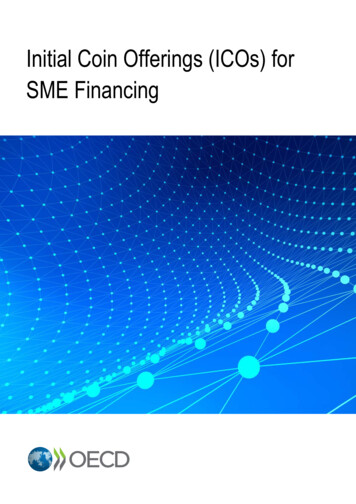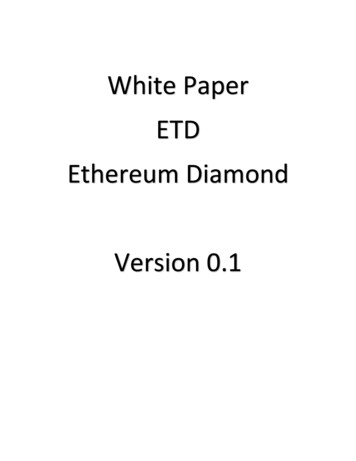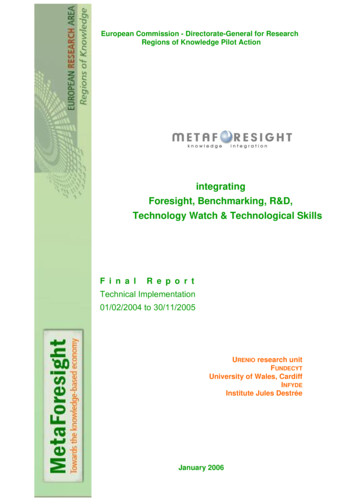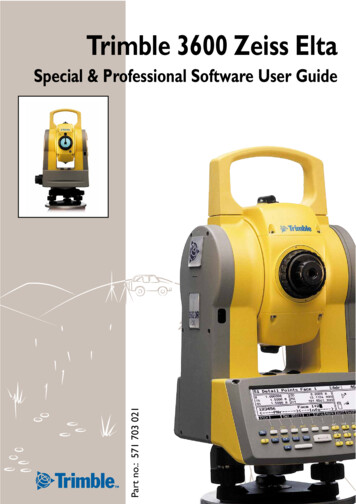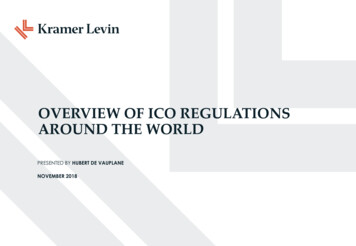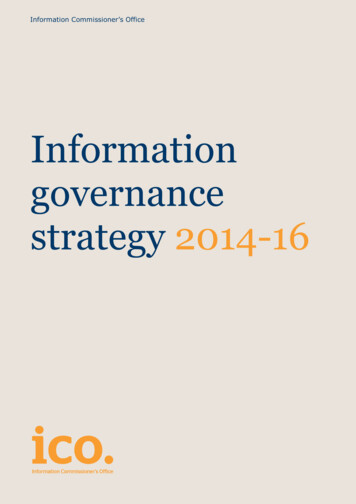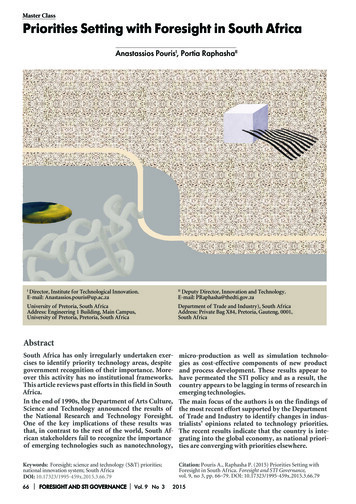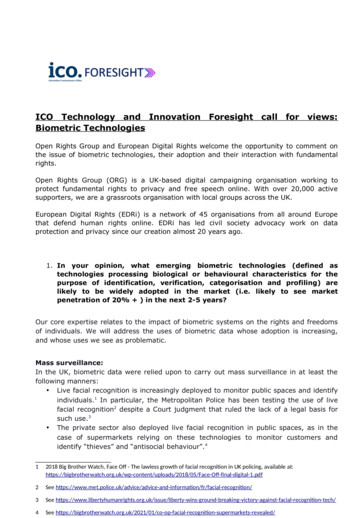
Transcription
ICO Technology and Innovation Foresight call for views:Biometric TechnologiesOpen Rights Group and European Digital Rights welcome the opportunity to comment onthe issue of biometric technologies, their adoption and their interaction with fundamentalrights.Open Rights Group (ORG) is a UK-based digital campaigning organisation working toprotect fundamental rights to privacy and free speech online. With over 20,000 activesupporters, we are a grassroots organisation with local groups across the UK.European Digital Rights (EDRi) is a network of 45 organisations from all around Europethat defend human rights online. EDRi has led civil society advocacy work on dataprotection and privacy since our creation almost 20 years ago.1. In your opinion, what emerging biometric technologies (defined astechnologies processing biological or behavioural characteristics for thepurpose of identification, verification, categorisation and profiling) arelikely to be widely adopted in the market (i.e. likely to see marketpenetration of 20% ) in the next 2-5 years?Our core expertise relates to the impact of biometric systems on the rights and freedomsof individuals. We will address the uses of biometric data whose adoption is increasing,and whose uses we see as problematic.Mass surveillance:In the UK, biometric data were relied upon to carry out mass surveillance in at least thefollowing manners: Live facial recognition is increasingly deployed to monitor public spaces and identifyindividuals.1 In particular, the Metropolitan Police has been testing the use of livefacial recognition2 despite a Court judgment that ruled the lack of a legal basis forsuch use.3 The private sector also deployed live facial recognition in public spaces, as in thecase of supermarkets relying on these technologies to monitor customers andidentify “thieves” and “antisocial behaviour”.412018 Big Brother Watch, Face Off - The lawless growth of facial recognition in UK policing, available ds/2018/05/Face-Off-final-digital-1.pdf2See ation/fr/facial-recognition/3See gnition-tech/4See l-recognition-supermarkets-revealed/
Further, it is worth mentioning that many video surveillance companies are sellingbiometric-ready CCTVs cameras.5 This is particularly worrisome in a country like theUnited Kingdom, which has a vast network of surveillance cameras 6 that risk beingrepurposed with live facial recognition.Identity checks and fraud detection:We distinguish these from live facial recognition because biometric data is used to carryout identity checks against specific individuals. These include, in particular, the use ofbiometrics to conduct automated checks on the identity of drivers by Uber and other gigeconomy employers for fraud detection. 7Age estimation:These technologies present the distinctive feature of using biometric data for the purposeof estimating internet users’ age.Identity providers and “safety tech” companies have been working on age estimationsolutions. Further, we understand from their recent consultation that the ICO areconsidering the adoption of these technologies to implement the age assurance code. 8Worryingly, the BBC has reported on a public-private partnership between UKsupermarkets and the UK Home Office to pilot biometric age ‘verification’ when purchasingalcohol.9 Such an example also raises concerns of mass surveillance given the involvementof the state in such a project.Biometric categorisation:These technologies profile people’s physical, physiological or behavioural characteristics tosort them into categories such as gender or even race, as advertised by Spanish companyHerta Security.10 They can form a component of identification systems or stand alone.Their use poses a severe risk of discrimination as well as risks of consumer manipulation,infringements on free choice and threats to people’s dignity.Emotion recognition:Emotion recognition functions as a sub-set of biometric categorisation, whereby it analysespeople’s facial movements or other physical, physiological or behavioural signals in orderto predict their emotional state or intention. Despite lacking a credible scientific basis, ithas already been used widely by states for monitoring public spaces and at EU borders forattempted ‘lie detection’ (polygraph) purposes (iBorderCtrl). It is also increasingly used bycompanies as a way to profile, track and manipulate shoppers. 115See EDRi, The Rise and Rise of Biometric Mass Surveillance in the EU, p.23. Available I RISE REPORT.pdf6See The Telegraph, One surveillance camera for every 11 people in Britain, says CCTV survey. Available itain-saysCCTV-survey.html7See 2021 Worker Info Exchange, Managed by bots. Available at: ed-by-bots8See 2021 ICO opinion: age assurance for the children’s code. Available at: ed-by-bots9See: https://www.bbc.com/news/technology-6021525810 See: /01/Screenshot 2020-01-28-BIOMARKETING 2-pdf.png11 See: https://visionlabs.ai/industries/retail
‘Seamless’ travel (closed-set biometric identification tunnels and kiosks):There is also a growing recourse for ‘seamless’ biometric systems which aim to identifypeople without that person needing to make any intervention e.g. simply by walkingthrough a tunnel which has been equipped with biometric cameras or sensors. An exampleof a closed-set biometric identification tunnel is the UK’s ‘Protect EU’ project. 12Closed-set biometric identification kiosks are increasingly used by commercial entities, forexample to speed up check-in for travel. One example is the December 2021 pilots ofclosed-set biometric identification kiosks at the St Pancras Eurostar terminal in London,about which many privacy and data protection concerns were raised. 13 Such kiosks arealso appearing at sports venues around the world.Such use cases pose big risks of normalising biometric technology, and entail many of thesame risks as mass surveillance systems as well as issues surrounding data security andmisuse / re-use of data (especially when implemented by commercial entities).2. What sets the emerging technology apart from existing solutions andapproaches?Attempts to circumvent existing data protection laws and ethical values:We are increasingly seeing attempts by vendors, researchers and companies to findloopholes and exploit grey areas in order to conduct the processing of biometric data, orphysical, physiological or behavioural data which does not uniquely identify people butwhich still poses risks to their fundamental rights. For example: The increasing use of non-uniquely-identifying data in the advertising context (e.g.biometric categorisation via “smart” adverts / billboards) in an attempt to avoid theGeneral Data Protection Regulation / Data Protection Act; Increasing transient processing / edge processing, leading to vendors claiming that itdoesn't really count as processing; Word-of-mouth reports of attempts to develop biometric identification / processinghardware in order to avoid rules on software; There is a strong trend of companies re-framing closed-set biometric identification asbiometric “authentication” so that people mistake it for biometric verification. A notableexample is the Facebook platform which, upon announcing that it was ending its facialrecognition services, stated that it was moving towards facial authentication. 14 Anotheris the Eurostar example.15 ‘Traditional’ CCTV cameras being sold with ‘biometric-ready’ capabilities, meaning thatthey have the potential to be turned into systems which process biometric data, butmay not have gone through the proper assessments for the processing of biometricdata.1612 See: https://twitter.com/protect eu13 See: 942522.html14 See: -face-recognition/15 See: 942522.html16 See EDRi’s 2021 report: e-netherlands-and-poland/
3. What forms of biometric data are these likely to capture and how?Companies are increasingly innovating with a wide range of biometric data as well as nonuniquely-identifying physical, physiological and behavioural data. For example, during theCOVID-19 pandemic, companies have focused on making the identification of individualsvia just their eyes and the areas surrounding the eyes (e.g. the part of the face leftexposed when wearing a mask) more accurate, increasing their ability to covertly trackpeople across time and place.Furthermore, we have received reports of experimentations with the following features /methods: Identification via the way that someone’s buttocks and thighs distribute pressure on achair / other surface Identification via breath print Identification via tongue Identification via ear canal Identification via pheromones / body odour Categorisation of people into protected groups on the basis of their physical,physiological or behavioural data Categorisation of consumers for the purpose of tracking and advertising (bringing thefeatures of the online AdTech ecosystem into physical stores via people’s physical,physiological or behavioural characteristics) ‘Emotion recognition’ ‘AI lie-detectors’4. Are these technologies likely to focus on verification/ identification orclassification of individuals?As a general tendency, we are seeing closed-set identification applied in the commercialcontext for purported efficiency reasons (e.g. queue management / speedy check-in) andverification for purported security reasons. In the law enforcement context we are seeing arise in identification uses. When it comes to classification, we are increasingly seeing itdeployed for advertising / consumer manipulation to put consumers into categories; andfor public / state uses (sometimes alongside identification) to classify people’s emotionalstates.5. How might these technologies benefit individuals and the use of theirpersonal data?The use of genuine verification use cases fully within a user’s control may benefitindividuals by allowing them to claim / prove their identity whilst keeping all theirbiometric data in a chip or device which they own, have control over, to which no thirdparties can access, which does not rely on any central or remote database / datarepository. However, this will only be the case if such a use case is also fully compliantwith the GDPR and the Data Act (including having a clear legal basis, a DPIA, evidence ofnecessity and proportionality and so forth) as well as human rights rules.Any other biometric use case of which we are aware comes with risks to people’sfundamental rights. Some of these risks may be mitigable via safeguards, but others arefundamentally incompatible in a democratic society (such as the use of remote biometricidentification in publicly accessible spaces, by any actor, and whether real-time or post)This ranges from risks of discrimination, violations of privacy and abuse sensitive data tosocietal-level impacts such as the suppression of protest and a chilling effect. There arealso risks relating to the security of their data and the normalisation of biometric systems.Whilst the biometrics industry frequently claim that their technologies can improveefficiency, we reassert that efficiency is not a legal basis. Claims that biometric
technologies are useful in preventing serious crime also lack any objective evidence,instead relying on vendors’ technosolutionistic claims about what their systems can do.6. How might these technologies present risks to individuals and the uses oftheir personal data? How could these risks be mitigated?We start by identifying the issues that arise with the use of biometric data generally. Wethen compare these risks against the uses outlined above.Sensitivity: biometric data are intrinsically linked to the human body, and they are inprinciple inalterable throughout life. Their sensitivity is recognised by Article 9(1) of the UKGDPR, which classifies them as “special category data” and prohibits the use of biometricdata for identification. Similar considerations underpin article 6 of the ModernisedConvention 108 of the Council of Europe, which prohibits the processing of “biometric datauniquely identifying a person” unless appropriate safeguards against discrimination areenshrined in law.It is also worth mentioning that biometric data may reveal other sensitive information,such as ethnicity, gender and health conditions. If this is the case, sorting or classifyingindividuals based on non-identifying biometric data may still constitute processing of“special category data”.Intrinsic errors: All biometric systems, without exception, have some intrinsic errors thataffect their accuracy and efficacy. These can include errors concerning the processing ofbiometric data (false positives or false negatives) as well as errors in acquiring this data —for instance, in case of injuries, disabilities or other developmental traits of the individualsthat do not allow the collection of the relevant biometric data. 17It follows that biometric systems need adequate supervision and suitable alternatives forthose individuals who may be incapable or unwilling to hand over their biometric data.Fairness: practical applications of biometric systems often include solely automateddecision-making within the meaning of Article 22 of the UK GDPR. Further, and for reasonsseen in the section above concerning “intrinsic errors”, unsupervised biometric systemsare in any case likely to be incompatible with the principle of fairness enshrined both inArticle 5(1)a of the UK GDPR and Article 5(3)a of Modernised Convention 108. Indeed, itwould be unfair to require data subjects to supervise the accuracy and resulting outputs oferror-prone systems they do not control.Legitimacy: processing personal data for lawful and legitimate purposes is a legalrequirement under Article 5(1)a of the UK GDPR and Article 5 of the ModernisedConvention 108.Law enforcement and presumption of innocence: in the field of data processing forlaw enforcement purposes, data subjects must be treated differently according to whetherthey are convicted, investigated, or otherwise linked to an investigation. This principle is17 2014 (edited 2020) Council of Europe PROGRESS REPORT ON THE APPLICATION OF THE PRINCIPLES OF CONVENTION108 TO THE COLLECTION AND PROCESSING OF BIOMETRIC DATA, Section 6.1 p.48. Available 014-edited-2020/16809e5412
enshrined in Article 6 of the Law Enforcement Directive and Section 38(3) of the UK DataProtection Act 2018 (UK DPA). Further, processing biometric data of individuals in thiscontext may breach the presumption of innocence.Risks related to age assurance applications: Sensitivity: we are concerned by the impact that widespread adoption of ageestimation would have on the security of sensitive data. Even where biometric datais not used for identifying data subjects, the risk of this data being leaked and one'sbiometric features resulting compromised remains substantial. Processing biometricdata to allow access to websites and internet services significantly increases thecollection and transfer of this data, thus increasing the likelihood of leaks, forinstance, as the result of data breaches or misuses. Intrinsic errors: making access to websites or services dependent on the processingof biometric data inherently exposes individuals to the risk of being unfairly deniedaccess to such services, either for an error in the processing or because they areunable to provide the necessary biometric data. Fairness: age estimation inherently constitutes solely automated data processingunder Article 22 of the UK GDPR: it automatically classifies internet users as aboveor below a certain age threshold, and it is unrealistic to expect that serviceproviders would be able to provide meaningful supervision in real-time. Ex-posthuman review (for instance, an appeal against an erroneous age estimation) seemsunsuitable for this particular application, as it would still frustrate and delay internetusers’ access to legitimate content for reasons that are ultimately outside of theircontrol.Risks related to identity checks and fraud detection:All the issues mentioned above would still be present if not exacerbated by the impact thatan accusation of fraud or criminal conduct may cause on the individuals being affected.On top of that, we ought to stress that facial recognition has shown the potential toperpetuate biased outcomes against people of colour and other ethnic minorities. Theissue is widely recognised even by the companies who develop facial recognitionproducts,18 which led to suspensions or moratoria against these systems due to the BlackLives Matter debate. Thus: On sensitivity: biometric data related to facial recognition are intrinsically revealingor suggestive of someone’s ethnic background. On intrinsic errors: underrepresentation of ethnic minorities is a driver of errors infacial recognition, as models are trained on data sets that may reproduce orperpetuate pre-existing biases or unbalances. On fairness: discrimination based on one's ethnic background is an obviously unfairoutcome.Risks related to mass surveillance:The use of live facial recognition to monitor public spaces exacerbates the issuesconcerning age estimation and identity checks for fraud detection. Live facial recognitionraises further issues in relation to:18 See Microsoft, Facial Recognition: It’s Time for Action. Available 12/06/facial-recognition-its-time-for-action/
Legitimacy: supermarkets using live facial recognition to detect undesirable orarbitrarily defined “antisocial” individuals fail, prima facie, the most basic test ofprocessing data for a legitimate aim. It is for law enforcement authorities to decideif someone’s freedom of movement should be restricted and to what extent. Whilesupermarkets or the management of other publicly accessible places may have aduty to block or to report individuals who are behaving in a certain manner, denyingentrance in the absence of any problematic behaviour and on the sole basis of livefacial recognition matchmaking hardly constitutes a legitimate use of biometricdata. The same can be said about the purpose of identifying “thefts”: if convictedindividuals have not been subject to any security measure or restriction of theirfreedom of movement, preventing them from accessing supermarkets has no legaljustification and ultimately serves an arbitrary and stigmatising purpose.Law enforcement and presumption of innocence: live facial recognitionexposes everyone to mass monitoring in public spaces, regardless of their criminalrecord or any other condition listed by Section 38(3) of the UK DPA. We believe thatlive facial recognition breaches the presumption of innocence for the same reason.7. What do you believe may be the key regulatory challenges to deploymentof the technologies?(see answer to question n.8)8. How do you believe regulators such as the ICO can best support thedelivery and implementation of these technologies in the future? Forexample, is sector specific regulation or guidance likely to be beneficial?We believe that the Council of Europe’s 2011 Parliamentary Assembly report (Report)provides useful recommendations on how the ICO can best supervise and enforce the lawagainst biometric technologies. Indeed, the United Kingdom is a member of the Council ofEurope and a signatory of both the European Convention of Human Rights and theModernised Convention 108. Further, the Report’s recommendations are deeply rooted inthe case-law of the European Court of Human Rights, and reflected in the ModernisedConvention 108. These are:191. limiting their evaluation, processing and storage to cases of clear necessity, namelywhen the gain in security clearly outweighs a possible interference with humanrights and if the use of other, less intrusive techniques does not suffice;2. providing individuals who are unable or unwilling to provide biometric data withalternative methods of identification and verification;3. working with template data instead of raw biometric data, whenever possible;4. enhancing transparency as a pre-condition for meaningful consent and, whereappropriate, facilitating the revocation of consent;5. allowing individuals access to their data, and/or the right to have it erased;6. providing for appropriate storage systems, in particular by reducing central storageof data to the strict minimum;19 2014 (edited 2020) Council of Europe PROGRESS REPORT ON THE APPLICATION OF THE PRINCIPLES OF CONVENTION108 TO THE COLLECTION AND PROCESSING OF BIOMETRIC DATA, Section 3.1 p.10. Available 014-edited-2020/16809e5412
7. ensuring that biometric data are only used for the purpose for which they have beenlawfully collected, and preventing unauthorised transmission of, or access to, suchdata.Their relevance also stands out compared with the biometric data we discussedbeforehand.Age estimation:The use of biometric data for age estimation raises issues with the principle of necessity,as: Biometric data breaches are irreversible, a risk that seems incompatible with thenotion of establishing age verification “in the best interest of children”. As reported by the ICO opinion on age assurance, there are alternatives to ageestimation. As Open Rights Group argued in our submission on the issue of ageassurance,20 these can generally be regarded as less intrusive, and age verificationdoes provide a suitable and more reliable alternative to high-risk scenarios (such asgambling websites).Further, there is an obvious risk that children may not understand or underestimate therisks of providing biometric data. It follows that providing alternatives to those “unable orunwilling to provide biometric data” is unlikely to be effective in this field.Fraud detection:The use of facial recognition for identity checks and fraud detection sometimes result inexclusionary or discriminatory outcomes. Thus, the recommendation of providing“alternative methods of identification and verification” clearly applies. Further, we stressthe importance of ensuring that companies who may need to carry out these identitychecks provide alternatives that are as easy to use and accessible as biometrics checks.We believe that either penalising individuals who choose not to rely on biometric checks orforcing them to under the prospect of a cumbersome verification procedure (or any otheradverse consequence) would frustrate the purpose of this recommendation.Finally, we point out Workers Info Exchange report findings on the use of facial recognitionby Uber, and the overall poor compliance of gig economy employers when it comes torespecting the right of access of their workers. The ICO should ensure that organisationsunderstand and comply with their legal obligations.Mass surveillance:In general, we stress the incompatibility of the use of live facial recognition in publicspaces with most of the Report’s recommendations: Treating everyone as a suspect is, other than contrary to the presumption ofinnocence, clearly unnecessary and disproportionate;It seems unlikely that data subjects could be given “alternative methods” of massidentity checks, nor it is clear why these methods should be any more necessary orcompatible with the presumption of innocence. Indeed, the decision not to introduceidentity cards in the UK was underpinned by the principle that doing so would havemeant treating everyone as a suspect;20 Available at: oners-office/
Mass surveillance lacks transparency by definition, and individuals are unlikely toexpect to be exposed to this kind of surveillance in a public street;There is no evidence that individuals are being given or could be given anymeaningful right of access to live facial recognition data, even less considering thatthey would likely ignore their existence;Processing personal data of individuals who are not convicted nor linked with illegalactivities is already incompatible with the purpose of law enforcement and crimedetection, for which this data should have been collected.On top of these considerations, we must stress that the Metropolitan Police is still usinglive facial recognition despite a Court judgement that found the absence of a legal basisfor such use. Although such ruling did not ban live facial recognition, the fact that the METis carrying out these activities without addressing the shortcomings that the Court raiseddenotes an apparent disregard for the law. It would be inappropriate to condone the use ofhighly intrusive technologies like live facial recognition by organisations that show theirdetermination to operate beyond the boundaries of the law.9. What additional technological, legal and regulatory measures may beneeded to realise the benefits of the biometric technologies across a widespectrum of communities?We believe that any adoption of new technologies — and related legal and regulatorymeasures — should be wary of “technosolutionism”. We appreciate the ICO'sproactiveness in intervening against facial recognition for identity checks of pupils inschools’ canteens,21 and we believe that the focus should remain to rein in otherproblematic uses of biometric data.Another action that the ICO could take is to issue further guidance on the strict and limitedconditions in which the use of biometric systems might be necessary and proportionate, aswas recently done by the Dutch data protection authority in response to unlawful attemptsby the JUMBO supermarket chain to use facial recognition.2221 See BBC, Schools pause facial recognition lunch plans. Available at: https://www.bbc.co.uk/news/technology-5903734622 See: -wijst-supermarkten-op-regels-gezichtsherkenning (in Dutch)
hardware in order to avoid rules on software; There is a strong trend of companies re-framing closed-set biometric identification as biometric "authentication" so that people mistake it for biometric verification. A notable example is the Facebook platform which, upon announcing that it was ending its facial


